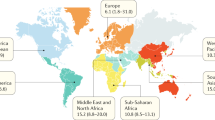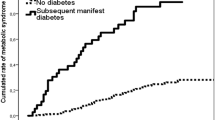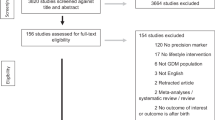Abstract
Gestational diabetes mellitus (GDM) affects approximately 4% of all pregnant women in the US and represents 90% of all cases of diabetes mellitus diagnosed during pregnancy. In addition to the adverse pregnancy outcomes associated with this complication, a history of GDM predisposes women to the future development of type 2 diabetes mellitus (T2DM). Incidence rates of GDM are increasing in the US. As a consequence, a growing number of women are now at increased risk for T2DM. Opportunities to diagnose and prevent T2DM in women with a history of GDM include early diagnosis by postpartum screening and implementation of diabetes prevention measures. In this Review, we discuss current guidelines for postpartum screening, how they might be implemented, and who should take responsibility for screening individuals at risk of T2DM. In addition, we describe measures to prevent the onset of T2DM in women with a history of GDM, focusing on lifestyle modifications, such as diet and breast-feeding.
Key Points
-
Gestational diabetes mellitus is increasing in prevalence, paralleling the trends in obesity and type 2 diabetes mellitus
-
Gestational diabetes mellitus places women at increased risk for the postpartum development of type 2 diabetes mellitus
-
Screening for type 2 diabetes mellitus is recommended to be performed at the 6-week postpartum visit, with additional surveillance testing at regular intervals depending on the risk assessment
-
Lifestyle modifications, such as a healthy diet, physical activity and breast-feeding, might serve to reduce, and potentially prevent, progression to type 2 diabetes mellitus
-
Further study is needed to determine the efficacy of additional interventions, such as pharmacotherapy, that aim to enhance type 2 diabetes mellitus risk reduction in women with a history of gestational diabetes mellitus
This is a preview of subscription content, access via your institution
Access options
Subscribe to this journal
Receive 12 print issues and online access
$209.00 per year
only $17.42 per issue
Buy this article
- Purchase on Springer Link
- Instant access to full article PDF
Prices may be subject to local taxes which are calculated during checkout
Similar content being viewed by others
References
American Diabetes Association (2006) Diagnosis and classification of diabetes mellitus. Diabetes Care 29 (Suppl 1): S43–S48
O'Sullivan JB and Mahan CM (1964) Criteria for the oral glucose tolerance test in pregnancy. Diabetes 13: 278–285
National Diabetes Data Group (1979) Classification and diagnosis of diabetes mellitus and other categories of glucose intolerance. Diabetes 28: 1039–1057
Carpenter MW and Coustan DR (1982) Criteria for screening tests for gestational diabetes. Am J Obstet Gynecol 144: 768–773
American Diabetes Association (2000) Gestational diabetes mellitus. Diabetes Care 23 (Suppl 1): S77–S79
World Health Organization (1999) Definition, diagnosis and classification of diabetes mellitus and its complications. [http://whqlibdoc.who.int/hq/1999/WHO_NCD_NCS_99.2.pdf] (accessed 7 July 2008)
Getahun D et al. (2008) Gestational diabetes in the United States: temporal trends 1989 through 2004. Am J Obstet Gynecol 198: 525.e1–5
Lawrence JM et al. (2008) Trends in the prevalence of pre-existing diabetes and gestational diabetes mellitus among a racially/ethnically diverse population of pregnant women, 1999–2005. Diabetes Care 31: 899–904
Ogden CL et al. (2006) Prevalence of overweight and obesity in the United States, 1999-2004. JAMA 295: 1549–1555
Mokdad AH et al. (2003) Prevalence of obesity, diabetes, and obesity-related health risk factors, 2001. JAMA 289: 76–79
Rosenberg TJ et al. (2005) Maternal obesity and diabetes as risk factors for adverse pregnancy outcomes: differences among 4 racial/ethnic groups. Am J Public Health 95: 1545–1551
Casey BM et al. (1997) Pregnancy outcomes in women with gestational diabetes compared with the general obstetric population. Obstet Gynecol 90: 869–873
Bentley-Lewis R et al. (2007) The metabolic syndrome in women. Nat Clin Pract Endocrinol Metab 3: 696–704
Metzger BE (2007) Long-term outcomes in mothers diagnosed with gestational diabetes mellitus and their offspring. Clin Obstet Gynecol 50: 972–979
Kim C et al. (2002) Gestational diabetes and the incidence of type 2 diabetes: a systematic review. Diabetes Care 25: 1862–1868
Ratner RE (2007) Prevention of type 2 diabetes in women with previous gestational diabetes. Diabetes Care 30 (Suppl 2): S242–S245
HAPO Study Cooperative Research Group (2008) Hyperglycemia and adverse pregnancy outcomes. N Engl J Med 358: 1991–2002
Järvelä IY et al. (2006) Gestational diabetes identifies women at risk for permanent type 1 and type 2 diabetes in fertile age: predictive role of autoantibodies. Diabetes Care 29: 607–612
Knowler WC et al. (2002) Reduction in the incidence of type 2 diabetes with lifestyle intervention or metformin. N Engl J Med 346: 393–403
Tuomilehto J et al. (2001) Prevention of type 2 diabetes mellitus by changes in lifestyle among subjects with impaired glucose tolerance. N Engl J Med 344: 1343–1350
Pan XR et al. (1997) Effects of diet and exercise in preventing NIDDM in people with impaired glucose tolerance. The Da Qing IGT and Diabetes Study. Diabetes Care 20: 537–544
American Diabetes Association (2004) Gestational diabetes mellitus. Diabetes Care 27 (Suppl 1): S88–S90
American College of Obstetricians and Gynecologists Committee on Practice Guidelines–Obstetrics (2001) ACOG Practice Bulletin. Clinical management guidelines for obstetrician-gynecologists. Number 30, September 2001 (replaces Technical Bulletin Number 200, December 1994). Gestational diabetes. Obstet Gynecol 98: 525–538
Gabbe S et al. (1998) Management of diabetes by obstetricians-gynecologists. Obstet Gynecol 91: 643–647
Gabbe SG et al. (2004) Management of diabetes mellitus by obstetrician-gynecologists. Obstet Gynecol 103: 1229–1234
Almario CV et al. (2008) Obstetricians seldom provide postpartum diabetes screening for women with gestational diabetes. Am J Obstet Gynecol 198: 528.e1–5
Kim C et al. (2007) Preventive counseling among women with histories of gestational diabetes mellitus. Diabetes Care 30: 2489–2495
Smirnakis KV et al. (2005) Postpartum diabetes screening in women with a history of gestational diabetes. Obstet Gynecol 106: 1297–1303
Russell MA et al. (2006) Rates of postpartum glucose testing after gestational diabetes mellitus. Obstet Gynecol 108: 1456–1462
Fisher EB et al. (2002) Behavioral science research in the prevention of diabetes: status and opportunities. Diabetes Care 25: 599–606
Feig DS et al. (1998) Self-perceived health status of women three to five years after the diagnosis of gestational diabetes: a survey of cases and matched controls. Am J Obstet Gynecol 178: 386–393
Kim C et al. (2007) Risk perception for diabetes among women with histories of gestational diabetes mellitus. Diabetes Care 30: 2281–2286
Smith-Morris CM (2005) Diagnostic controversy: gestational diabetes and the meaning of risk for Pima Indian women. Med Anthropol 24: 145–177
Kieffer EC et al. (2002) Perspectives of pregnant and postpartum Latino women on diabetes, physical activity, and health. Health Educ Behav 29: 542–556
National Diabetes Education Program diabetes prevention campaign [http://ndep.nih.gov/diabetes/pubs/Never_Too_Early_Feature.pdf]
Centers for Disease Control and Prevention (2008) CDC Features: diabetes and pregnancy [http://www.cdc.gov/features/DiabetesPregnancy/] (accessed 7 July 2008)
American Diabetes Association (2008) Standards of medical care in diabetes–2008. Diabetes Care 31 (Suppl 1): S12–S54
Stage E et al. (2004) Lifestyle change after gestational diabetes. Diabetes Res Clin Pract 63: 67–72
Keller C et al. (2008) Interventions for weight management in postpartum women. Obstet Gynecol Neonatal Nurs 37: 71–79
O'Toole ML et al. (2003) Structured diet and physical activity prevent postpartum weight retention. J Womens Health (Larchmt) 12: 991–998
Leermakers EA et al. (1998) Reducing postpartum weight retention through a correspondence intervention. Int J Obes Relat Metab Disord 22: 1103–1109
Kjos SL et al. (1993) The effect of lactation on glucose and lipid metabolism in women with recent gestational diabetes. Obstet Gynecol 82: 451–455
Taylor JS et al. (2005) A systematic review of the literature associating breastfeeding with type 2 diabetes and gestational diabetes. J Am Coll Nutr 24: 320–326
Dewey KG et al. (1993) Maternal weight-loss patterns during prolonged lactation. Am J Clin Nutr 58: 162–166
Dewey KG et al. (2001) Effects of exclusive breastfeeding for four versus six months on maternal nutritional status and infant motor development: results of two randomized trials in Honduras. J Nutr 131: 262–267
Rooney BL and Schauberger CW (2002) Excess pregnancy weight gain and long-term obesity: one decade later. Obstet Gynecol 100: 245–252
Ram KT et al. (2008) Duration of lactation is associated with lower prevalence of the metabolic syndrome in midlife–SWAN, the study of women's health across the nation. Am J Obstet Gynecol 198: 268.e1–6
Stuebe AM et al. (2005) Duration of lactation and incidence of type 2 diabetes. JAMA 294: 2601–2610
Larson-Meyer DE (2002) Effect of postpartum exercise on mothers and their offspring: a review of the literature. Obes Res 10: 841–853
McCrory MA et al. (1999) Randomized trial of the short-term effects of dieting compared with dieting plus aerobic exercise on lactation performance. Am J Clin Nutr 69: 959–967
Lovelady CA et al. (2000) The effect of weight loss in overweight, lactating women on the growth of their infants. N Engl J Med 342: 449–453
Buchanan TA et al. (2002) Preservation of pancreatic beta-cell function and prevention of type 2 diabetes by pharmacological treatment of insulin resistance in high-risk Hispanic women. Diabetes 51: 2796–2803
Xiang AH et al. (2006) Effect of pioglitazone on pancreatic beta-cell function and diabetes risk in Hispanic women with prior gestational diabetes. Diabetes 55: 517–522
Acknowledgements
This work was supported in part by NIH grants K23RR023333 to RB-L and K24 RR018613 to EWS. Charles P Vega, University of California, Irvine, CA, is the author of and is solely responsible for the content of the learning objectives, questions and answers of the Medscape-accredited continuing medical education activity associated with this article.
Author information
Authors and Affiliations
Corresponding author
Ethics declarations
Competing interests
The authors declare no competing financial interests.
Rights and permissions
About this article
Cite this article
Bentley-Lewis, R., Levkoff, S., Stuebe, A. et al. Gestational diabetes mellitus: postpartum opportunities for the diagnosis and prevention of type 2 diabetes mellitus. Nat Rev Endocrinol 4, 552–558 (2008). https://doi.org/10.1038/ncpendmet0965
Received:
Accepted:
Published:
Issue Date:
DOI: https://doi.org/10.1038/ncpendmet0965
This article is cited by
-
Postpartum dietary and physical activity-related beliefs and behaviors among women with recent gestational diabetes mellitus: a qualitative study from Singapore
BMC Pregnancy and Childbirth (2021)
-
Sickness absence in pregnancy and sedentary behavior: a population-based cohort study from Norway
BMC Public Health (2019)
-
Effectiveness of a diabetes prevention program for rural women with prior gestational diabetes mellitus: study protocol of a multi-site randomized clinical trial
BMC Public Health (2018)
-
Appreciating Recent Motherhood and Culture: A Systematic Review of Multimodal Postpartum Lifestyle Interventions to Reduce Diabetes Risk in Women with Prior Gestational Diabetes
Maternal and Child Health Journal (2017)
-
Employing a Multi-level Approach to Recruit a Representative Sample of Women with Recent Gestational Diabetes Mellitus into a Randomized Lifestyle Intervention Trial
Maternal and Child Health Journal (2016)



